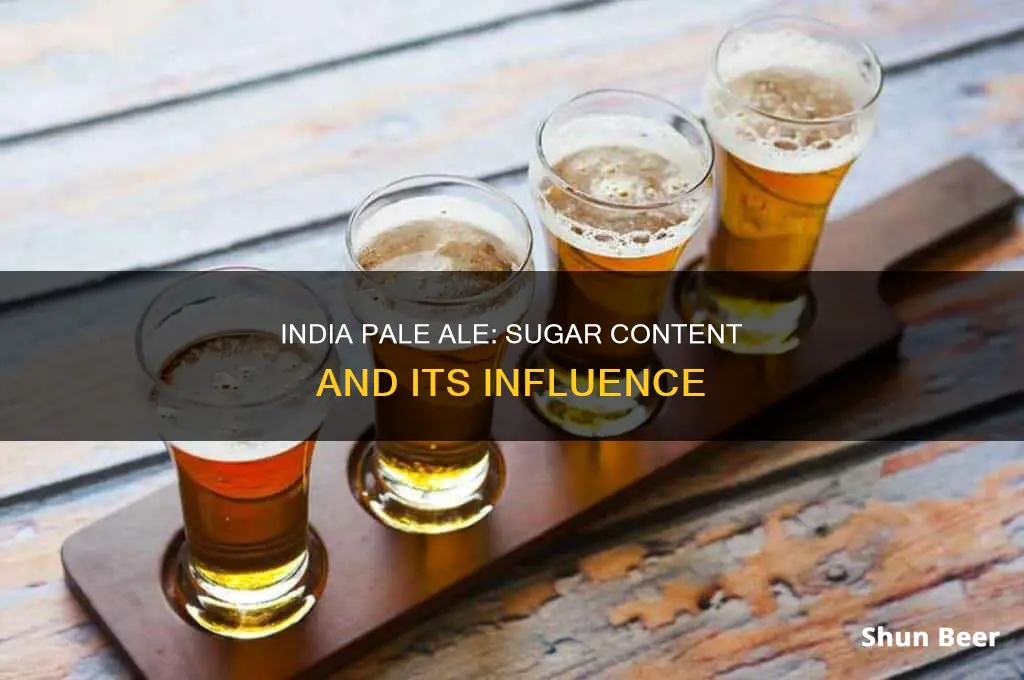
India Pale Ale (IPA) is a hoppy beer style that has become a staple on craft beer menus. It has a higher alcohol content and more hops than standard pale ales, giving it a bitter, floral, earthy, citrusy, piney, and fruity flavour. But does it have sugar in it?
What You'll Learn

The history of India Pale Ale
India Pale Ale, or IPA, is a hoppy style of beer within the broader category of pale ales. The name "India Pale Ale" dates back to the late 1700s when exporters of beer from the British Isles to India would add hops to their brews to help preserve the beer in hotter, more tropical climates. The beers were characterised by their lighter style and bitter, hoppy nature.
Early History
The British Indian Army and British citizens living in India drank porter, the most popular brew of the day in London. However, the beer would spoil during its long, six-month voyage to India. George Hodgson of London's Bow Brewery began sending his pale ale to India packed with extra hops and an increased alcohol content. Both the hops and high alcohol helped to preserve the beer during its long sea journey from England to India. This created a bitter and stronger pale ale that was more refreshing in the hot Indian climate compared to the dark ales and porters that were popular in London.
Wider Distribution
By the 1760s, breweries learned that adding extra hops to all of their beers helped fortify them for the voyage to the warmer climates. Not only were they adding hops to pale ales, but also porters and ales. The beer being exported wasn’t much stronger in alcohol content either. While Hodgson may not have been the first brewer to come up with the concept, he was the first to achieve a large amount of distribution in India. The Bow Brewery was popular with East India Company traders thanks to the brewery’s proximity to East India’s docks, as well as the fact that Hodgson sold the beer with a credit line of 18 months.
New Brewers
The East India Company eventually grew tired of Hodgson’s unscrupulous business practices and began looking for new brewing partners. They found some in Burton upon Trent, where the brewers had lost their valuable export markets in Russia after it was banned by the Tsar. The Allsopp, Bass and Salt breweries improved on Hodgson’s recipe for hopped pale ale and took over the Indian market.
Wider Popularity
By the early 19th century, "pale ale prepared for the India market" was gaining in popularity as exports increased, as well as hopping levels. The first known recorded mention of the phrase "India Pale Ale" came in 1835 in an edition of the Liverpool Mercury. Beer drinkers in England eventually got to taste this export style of pale ale by the 1830s, and by 1840, the India pale ale became one of England’s best-selling beers.
Beer and Diabetes: Is There Sugar in Beer?
You may want to see also

The brewing process of India Pale Ale
India Pale Ale (IPA) is a hoppy beer style within the broader category of pale ale. The brewing process of IPA involves several steps, and the final product is a result of variations in these steps. Here is a detailed description of the brewing process of IPA:
Malting
The first step in brewing any beer, including IPA, is malting. Barley is malted by sprouting the grains and then drying them in a kiln. This process prepares the barley for the next step in brewing.
Mashing
The malted barley is then mashed, or cooked with warm water, to create a sugary liquid called wort. The wort forms the base for the beer and will eventually be fermented to produce alcohol.
Boiling
The wort is then boiled with flavouring hops. This step helps to sanitise the wort and also contributes to the flavour and bitterness of the final beer. Different varieties of hops can be used to create different flavour profiles.
Fermentation
After boiling, the wort is cooled and then fermented with yeast. Fermentation is a critical step in the brewing process, as it is during this stage that the sugar in the wort is converted into alcohol. For ales, the fermentation occurs at room temperature, while for lagers, it occurs at cooler temperatures.
Aging and Packaging
Finally, the beer is aged and packaged. Aging can occur in tanks, barrels, or bottles, and the duration of aging can vary depending on the desired flavour profile. After aging, the beer is packaged into cans, bottles, or kegs for distribution and consumption.
It is important to note that the brewing process can vary depending on the specific type of IPA being produced (e.g., West Coast IPA, New England IPA, etc.) and the individual brewer's techniques and preferences. Additionally, while the traditional IPA was formulated to survive long voyages, modern IPAs may focus more on emphasising hop aromas and flavours while reducing bitterness.
Beer and Blood Sugar: A Surprising Relationship
You may want to see also

India Pale Ale's popularity
India Pale Ale, or IPA, is the most popular style of craft beer. It is characterised by its signature bitterness, derived from the hops used in the brewing process.
The story of the IPA's origin is well-known: it was created to withstand the long voyage from England to India in the 18th and 19th centuries. However, this story is not entirely accurate. While the beer was exported to India, its creation was not solely due to the need for preservation during the journey. The IPA was simply a hoppy ale that proved popular among British colonists in India.
The style experienced a revival in the 1980s when American craft brewers reintroduced it using North American ingredients, particularly bright, bold, and bitter American hops. The resurgence of the IPA can be attributed to several factors. Firstly, more breweries are producing IPAs, offering them to consumers, and there are more consumers who are familiar with the flavour profile of IPAs. The bold and mysterious nature of IPAs also contributes to their popularity. They are considered advanced beers that showcase a refined palate, making them a safe and confident choice for beer enthusiasts.
The popularity of IPAs has led to a growing trend, with craft brewers increasingly making them a staple of their selection and bars featuring them prominently in their rotations. The buzz around IPAs is such that any beer with a strong flavour and a notable presence of hops tends to be labelled as an IPA. This popularity has also sparked a sense of competition among drinkers, with a "natural sense of competition" regarding how much hops one can handle.
The IPA's status as the king of craft beers may not last forever, as its success has caught the attention of macro brewers, who may use their established brands and loyal fans to capitalise on the style's popularity. However, for now, the IPA reigns supreme, with its bold flavours and high alcohol content attracting drinkers worldwide.
Goldberg Beer: Sugar Content and Nutritional Facts
You may want to see also

Different types of India Pale Ale
India Pale Ale (IPA) is a hoppy beer style within the broader category of pale ale. While IPAs are generally known for their high hops content, they can be categorised into several types with distinct flavours, colours, and alcohol content. Here are some of the most common types of IPAs:
American IPA
The American IPA is often divided into two categories: East Coast and West Coast. The "West Coast IPA" typically refers to a more aggressively hoppy and bitter flavour profile, with classic Northwest hop flavours like citrus, pine, florals, and a strong bitterness. In contrast, "East Coast IPAs" are slightly more balanced, with a stronger malt component that matches the robust hops presence.
Belgian IPA
Belgian IPAs are a recent hybrid style inspired by the popularity of American IPAs. They are heavily hopped, often with American hop varieties, and may be made with different types of malts. However, what sets them apart is the use of Belgian yeast strains in bottle conditioning, resulting in a dry, assertive bitterness that pierces through the malt and yeast-derived flavours.
English IPA
English IPAs are believed to have originated when clever 18th-century Brits dosed their pale ale with extra hops and malt for the journey to India, resulting in higher alcohol content and bitterness. They are less intensely hoppy than American IPAs and strike a balance between malt and hop flavours. English IPAs may also showcase some toasty and bready malt notes, along with fruity esters from English yeast.
Imperial (Double) IPA
Double IPAs, also known as Imperial IPAs, are a stronger and very hoppy variant of IPAs. They typically have an alcohol content above 7.5% by volume, achieved by adding more ingredients, especially hops, to the brew. The dominating flavour profile is hoppy, with bitterness complemented by notes such as fruit, citrus, pine, florals, earth, and resin.
Black IPA
Black IPAs, also known as Cascadian Dark Ales (CDA) or American Black Ales, are a newer style. While they retain the aggressive hoppiness of a West Coast IPA, they incorporate roasted malts that lend chocolate, coffee, and other dark notes to the overall flavour. Caramel and fruit notes may also be present, but the beer is not overly sweet.
Rye IPA
Rye IPA is a style of IPA that incorporates rye into the malt. It retains the aggressive hoppiness of a West Coast IPA while the spiciness of rye amplifies the citrusy, piney hops flavour and adds complexity to the malt.
New England IPA (NEIPA)
The New England IPA, also known as Hazy IPA or Juicy IPA, is currently one of the most popular styles. It is unfiltered, resulting in a hazy appearance, and has extremely low bitterness. These IPAs emphasise hop aroma and showcase juicy citrus and floral flavours. They tend to have a smooth consistency and a fruity, cobbler-like taste.
Session IPA
Session IPAs are characterised by lower alcohol content, typically below 5% ABV. With reduced alcohol comes a thinner body, making these beers ideal for drinking multiple servings in one sitting.
Milkshake IPA (Lactose IPA)
Milkshake IPAs, also known as cream IPAs, do not contain milk but get their nickname from the sweetness added by milk sugar (lactose). Fruit or vanilla may be included to further enhance the sweetness. They have low carbonation and often resemble a fruity milkshake in taste and smoothness.
Beer and Blood Sugar: What's the Connection?
You may want to see also

Food pairings with India Pale Ale
India Pale Ale (IPA) is a hoppy beer style that has gained popularity as a staple on craft beer menus. The beer is characterised by its strong, bitter, and fruity flavour profile. When pairing an IPA with food, it is important to match the intensity of the flavours in the dish and the beer. Here are some food pairings to consider with an IPA:
Spicy and Savoury Dishes
The carbonation and bitterness of an IPA make it a great pairing with spicy and savoury dishes. The carbonation helps to cut through the fat and reset the palate, while the bitterness amplifies salty and umami flavours. Try pairing an IPA with Thai and Indian cuisine, such as a chicken tikka masala or a French cassoulet. The carbonation will cut through the rich and creamy sauces, while the bitterness will complement the spices used in these dishes.
Salty and Fried Food
The bitterness of an IPA also pairs well with salty and fried foods. The salt and fat in these dishes help to tone down the bitterness of the beer and highlight the malt flavours. For example, a plate of fried chicken or Wisconsin cheese curds would go well with an IPA.
Grilled Meat
IPAs are fabulous with grilled meat, especially when there is a caramelized crust. The caramelization pulls out the caramel malt in the beer, while the hop flavour and bitterness provide a contrasting umami flavour. Fire up the grill and pair your IPA with burgers and steaks.
Dessert
While it may seem unexpected, IPAs can also pair well with certain desserts. Slightly sweeter IPAs, such as an English-style or maltier American IPA, can complement the flavours of tamarind or ginger spiced chocolate truffles. The malt in the beer heightens the caramel side of milk chocolate, while the hops intensify the spice. Another dessert option is carrot cake, which pairs well with the spice and citrus notes found in some IPAs.
Beer's Sodium and Sugar Content: What You Need to Know
You may want to see also
Frequently asked questions
India Pale Ale (IPA) beers do contain some sugar, but the amount varies depending on the specific brewing process and style of IPA. Traditional IPAs tend to have fewer residual sugars due to a higher proportion of fermented wort.
Traditional IPAs, also known as British or English IPAs, have a more bitter flavour profile due to the longer resting time of hops in the beer. Modern IPAs, including American and West Coast styles, are known for their aggressive hoppiness and exploration of fruity notes.
There are numerous styles of IPAs, including but not limited to:
- Session IPAs: Lower alcohol content.
- Double or Imperial IPAs: Higher alcohol content and increased hop concentration.
- Hazy or New England IPAs: Unfiltered and often dry-hopped to enhance fruity flavours.
- Belgian IPAs: Made with Belgian yeast, combining characteristics of British IPAs and Belgian tripels.
- Black IPAs: Also known as Cascadian Dark Ales, with roasted malt flavours and a darker colour.







